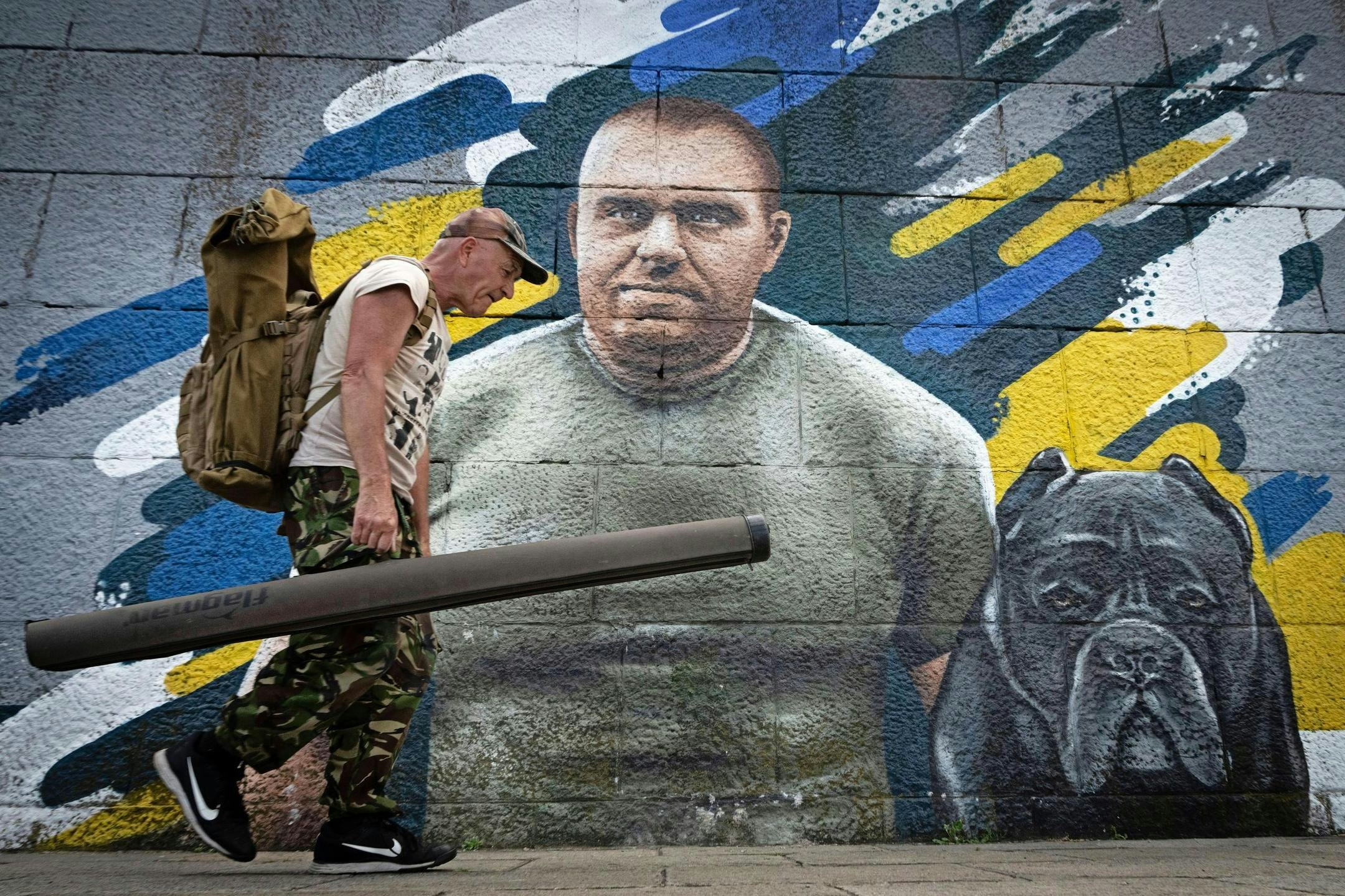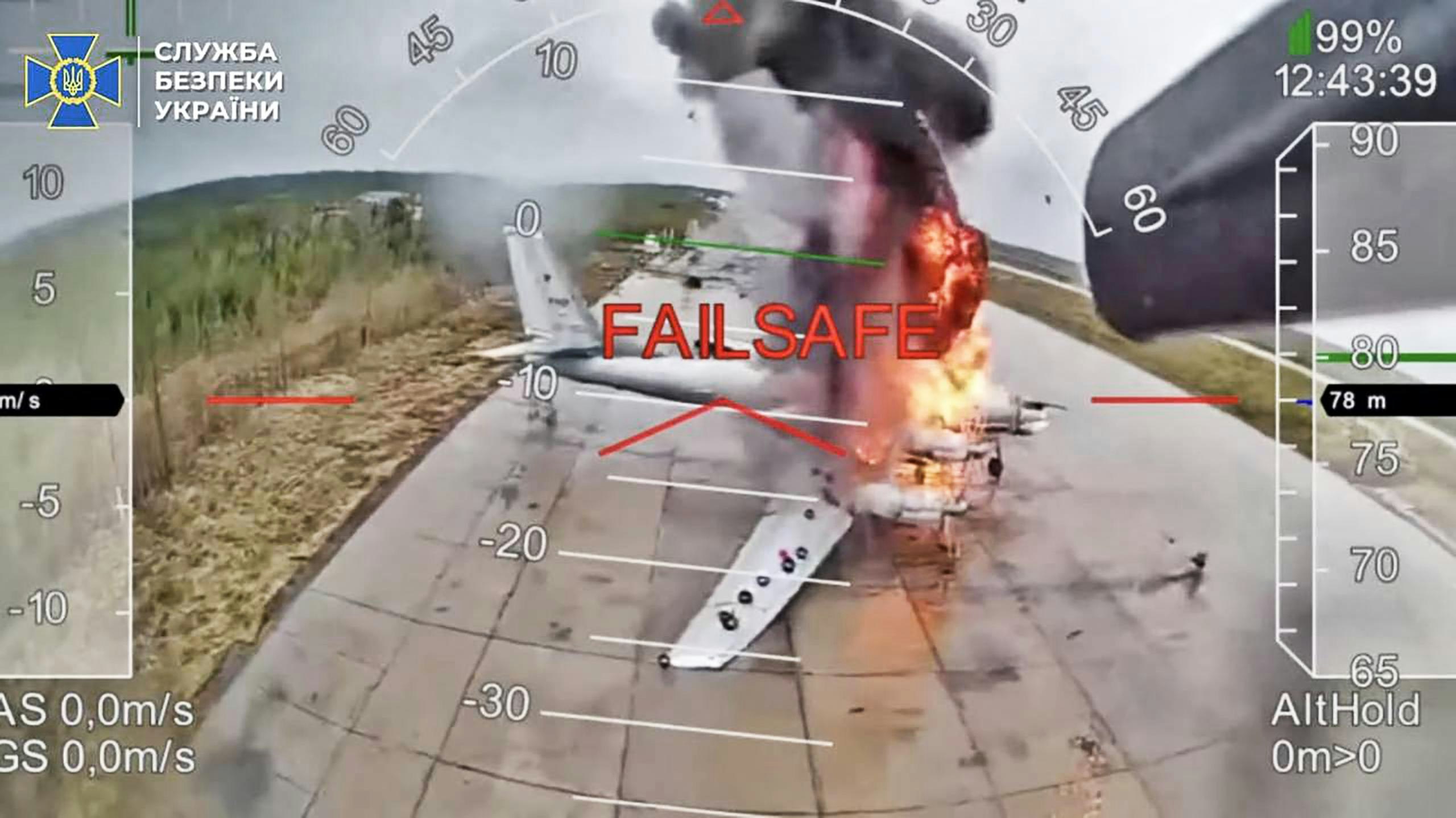This article is taken from the July 2025 issue of The Critic. To get the full magazine why not subscribe? Right now we’re offering five issues for just £25.
The greatest defence failures of history often originate from a lack of imagination. From the collapse of the walls of Jericho, as chronicled in the Book of Joshua; to the wooden horse left by the gates of Troy; to the monk-slaying expedition of the Vikings who raided Lindisfarne on 8 June 793, the inability to anticipate catastrophe has led to Armageddon.
At some stage in the past, instead of picking up a stone or club, Ug’s stone-age neighbour tied a sharpened flint to a pole and stabbed him to death. Generations later, Nog, armed with his spear, was impaled by a finely crafted arrow shot from afar.
The unknown genius who blended saltpetre, charcoal and sulphur into black powder to develop the first “fire-spurting bamboo lances” used by Chinese warriors in the 9th and 10th centuries, gifted 21-year-old Sultan Mehmed II the perfect futuristic weapon with which to pound the walls of Constantinople for 55 days, leading to its capture on 29 May 1453.
The fall of Constantine’s city and of the Byzantine Empire not only marked the end of the 1,500-year Roman Empire but is regarded as the end of the medieval and beginning of the early modern period. It was also a turning point in military history, with the most impregnable of stone fortifications overcome by gunpowder in an excellent example of the blue-sky thinking of one side and the lack of vision by their opponents.
Such asymmetry has continued ever since, notably via the battlefield use of chlorine gas in 1915 and Japanese swoop on Pearl Harbor of 1941, to the 11 September 2001 and 7 October 2023 attacks of our own times.

To these must now be added Operation Spider’s Web, Ukraine’s remotely piloted drone attacks on far distant Russian aerodromes on 1 July. Conveyed to the vicinity hidden in wooden containers driven by unsuspecting truck drivers, at the flick of a distant switch, swarms of unmanned machines rose into the air and hit many of the Kremlin’s armed and fuelled strategic bombers, destroying 20–30 per cent of the entire fleet.
“It took 18 months and 9 days from the start of planning to execution of the operation, which spanned five oblasts across five time zones,” announced President Zelenskyy, savouring every juicy detail. Damage was particularly heavy at the Belaya Air Base in Eastern Siberia, where aircraft were lined up on the tarmac, wingtip to wingtip, and assumed to be safe from front line incursion, 2,700 miles away. Days later, in another audacious assault, more drones hidden in a railroad grain hopper were released by remote control, disabling its engine and the 13 tanks, seven artillery pieces and 103 armoured vehicles being pulled by the locomotive. Significantly, the United States was not alerted beforehand to either surprise attack, unthinkable in the pre-Trumpian era.
The reason why we were treated to Kyiv’s normally secret intelligence insights soon became apparent from their correct reading of Kremlin bureaucracy. Russian transport is literally now gridlocked as every container truck and rail carriage is searched by fearful and zealous militiamen, anxious to avoid a repeat performance on their watch, which would result in a one-way ticket to the front or defenestration from a tall building.
The scenario of anticipating an opponent’s behaviour several moves ahead could almost be a plot from Mission Impossible. President Zelenskyy and his men are undoubtedly masters of the modern digital battlefield. They have displaced Israel at the cutting edge of world military achievement.

Spider’s Web was a salutary lesson in Trumpian hubris and an appropriate riposte to the US President’s 21 February claim that “Ukraine has no cards left to play”. Kyiv has now won back the tactical initiative, if it had ever lost it, but does not have the strength to exploit the moment and win the war. It is rather like the advent of British tanks on 15 September 1916 on the Somme or later at Cambrai on 20 November 1917, which caused long-lasting ripples in military history but couldn’t be successfully exploited for decisive victory at the time.
Poland recognised this moment by abruptly cancelling its plans to buy 32 Lockheed Martin S-70i Black Hawk helicopters for its armed forces, citing a “shift in defence spending priorities”.
Between the lines, their experts tell me of the “pointlessness of buying a new helicopter fleet that could be overwhelmed by a cheap, unmanned drone swarm”, a view gaining traction in many defence ministries.
The UK has apparently not been deterred from its proposed purchase of 44 of the same aircrafts but, doctrinally, drones are causing panic as it is too soon for the mists to clear and understand the full range of their capabilities and drawbacks.
★
Fighting for your life against Russia concentrates the mind wonderfully and makes all the difference to battlefield tactics: integrating vast drone fleets into all-arms combat is still on the distant horizon for most armed forces outside Ukraine. To continue the First World War analogy, victory in the West only came with the August 1918 battle of Amiens, when the allies perfected their war fighting doctrine and learned how to integrate all their newly-matured war-fighting assets (infantry, engineers, artillery, armour and air) and developed the human and machine strength to overwhelm their opponents during the subsequent hundred days campaign, culminating with the armistice of 11 November.
Ukraine isn’t at this point yet and on current form is finding its Amiens moment elusive. Meanwhile, dithering Western support and Putin’s determination to reinforce failure to at least reel in a face-saving pyrrhic victory (tactics which eventually worked for his predecessor in the Russo-Finnish war of 1939–40 and against the Germans after 1942) seem merely a recipe for a long, drawn-out conflict that is likely to end in mutual exhaustion.
After years of vituperative diplomatic mudslinging, neither side will suddenly forgive and forget but instead pause, reconstitute and start round two. Pointing to the bigger wheels of history, I might observe that is what happened in the last century in Europe: the war that began in 1914 ended not in 1918, but in 1945 after a two-decade breather in the middle.
Western support, whether formerly American or that of the current EU and non-US NATO, is with Ukraine “for as long as it takes”. The phrase first appeared on the first anniversary of the Russian invasion in February 2023 and was parroted by politicians without a thought as to what “it” is. All helped arm Ukraine well enough to avoid defeat but never enough to ensure victory.
The end state has never been clear, and its visualisation varies radically throughout the anti-Russian coalition. Do they mean the ejection of Russia from every scrap of Ukrainian territory? The further humbling of Moscow militarily, diplomatically and economically, so a repeat performance is impossible? The dismantling of the Russian Federation? Or maybe a frozen conflict with ceasefire lines à la Cyprus or Korea?
Some in the West are fearful of triggering regime change in Russia, on the basis that a Putin successor could be worse: better the devil you know. Many Europeans, notably businessmen, bankers and luxury goods manufacturers in Germany, Austria, Switzerland, Hungary, Istanbul and the Middle East, plus diamond merchants in Amsterdam, consider the whole business a ghastly mistake and wish everything would blow over so they can get back to trading with Moscow and handling the assets of its oligarchs, whilst ships’ chandlers in the fleshpots of Malta and Cyprus bemoan the departure of Russian luxury yachts to service and maintain.
Flushed from celebrating the 80th anniversary of VE Day, Westminster’s placing of military expenditure at the top of the Treasury’s spending programme for the first time since 1945 via the Strategic Defence Review (SDR) is a recognition in an era of unparalleled international uncertainty that warfare has grown beyond its traditional three domains of maritime, land and air to include three more: space, cyber and information.
Personnel numbers matter but so does new technology, and both send a message to the UK’s foes. With the UK’s civil defence infrastructure of bunkers and warning stations sold off, an inadequately-sized army, navy and air force, the Royal Fleet Auxiliary in crisis mode and recruitment to all declining, it has prompted Sky News to create the superbly-informed wargame podcast “What If Russia Attacked the UK?” It is well worth a glance.
However, we must worry that the SDR was predicated on a spend of 2.6 per cent of GDP, whilst the debate has already shifted to when 3 per cent will be attained. Some NATO members, including the US, are pushing for a further rise to 5 per cent. More money doesn’t mean more things; it opens the door to new programmes and capabilities.
The UK has always been geared to maximising defence and lethality from platforms rather than concentrating on mere numbers. Traditionally, well-resourced defenders should be able to inflict a loss rate of 3:1 on their attackers. As Russia’s human casualties coast towards the million mark, Ukraine has demonstrated that it’s possible to up that ratio with a wise use of doctrine and technology to 10:1.
A further problem arises in that hugging a defence spending figure of 2.6 per cent like a climber clinging to a rocky overhang fast becomes irrelevant in an international crisis and removes the inclination for the blue-sky thinking of those earlier Trojans, Vikings and Sultan Mehmed II. The trouble with fixed figures is they take no account of the fluidity of international security or advances in defence technologies, which are subject to their own dramatic cost rises above inflation.
All the six war-fighting domains are already being tested throughout Europe by the Kremlin, which suggest any ceasefire or peace in Ukraine that is not meaningful would merely provide Russia with the necessary pause to re-equip, train and re-arm before embarking on a new kinetic adventure. Subsea cables have been cut far outside the combat zone, and, as I write, Sweden is currently investigating the “unexplained sabotage attacks” on 30 mobile phone masts along its coastline. Stockholm police hint there is only one serious contender for the crime.
In the wake of arson attacks in 2024 on factories supplying Ukraine in Berlin and London and a Bulgarian spy ring working for Moscow recently uncovered and jailed in the UK, a senior NATO official announced there had been a Russian plot to kill Armin Papperger, head of German arms manufacturer Rheinmetall. “We have seen incidents of sabotage taking place across NATO countries over the last couple of years, by which I mean derailment of trains, acts of arson, attacks on politicians’ property, plots to assassinate industry leaders,” he observed. “We need a war mentality because there is a continuous and escalating campaign of destabilisation against all of our countries.”
In the event of any cessation of hostilities, Moscow would require a period to restock, ease the stress on its economy and devise new doctrine. For Putin, his “special military operation” ceased long ago to be about Ukraine. Every day has confirmed his deep-seated belief that the West is fundamentally hostile to Russia. In his eyes (transmitted to all Russia by his media), their response in helping Kyiv is part of that far deeper narrative.
The smart money is on a maximum of a decade for complete Russian military reconstitution, with “dry runs” such as sabotage and assassination to maintain the initiative and test scenarios against a range of targets, of whom the Baltics seem most likely in the Kremlin’s firing line.
Meanwhile, any American bulldozing of Kyiv to acquiesce in Russian demands that the Donbas and Crimean regions permanently secede from Ukraine might trigger a new wave of kinetic breakaways from separatists or “unification” invasions elsewhere across the globe.
★
Much of the Western debate has concerned the means of Ukraine’s survival, not the end. This turns conventional Clausewitzian strategy-making on its head. Traditionally, whether in statecraft, war or business, there must be a definition of a desired outcome, from which is derived the means to achieve it. Volodymyr Zelenskyy is very good at drumming up international support for the means — more tanks, infantry fighting vehicles, longer-range rockets, air defence missiles. His end, if not that of his allies, is crystal clear: Russia out.
However, with Ukraine entirely reliant on outside assistance to prevail, not unlike France or Belgium during the First World War, we are duty bound to ask, as that help wavers, morphs and wobbles, what could Zelenskyy have done differently to better further the means to his end?
In many ways, it is difficult to fault his inspirational leadership. From his selfless refusal of exile in February 2022 when he stated, “The fight is here; I need ammunition, not a ride,” he has so far played an extraordinarily good game with an initially very poor hand of cards. Through his example and nightly addresses, not unlike Winston Churchill in 1940, he has forged in Ukraine a cohesive sense of identity, previously lacking.
On my most recent visit to Lviv, after lingering in an air raid shelter listening to the motors of Russian rockets whooshing overhead, I was taken to see the assembly of drones in people’s houses and the repurposing of damaged and captured tanks in small workshops — part of the great national resourcefulness Zelenskyy has encouraged, alongside some quite breathtaking military strikes against his larger opponent.
However, we might single out two areas where Ukraine might have benefitted from a different approach. From the start, Zelenskyy chose to preserve his youth and not to conscript 18-to-27-year-olds, instead mobilising those up to 60. Only in April 2024 was the age threshold reduced to 25. Kyiv’s greatest internal battle has been its self-imposed recruitment crisis, with continued street-sweeps and raids on public places by law enforcement to net evaders producing extreme public hostility.
Commanders assess their lack of personnel to be a greater crisis than shortage of ammunition. An estimated 60,000 eligible for the draft are still at large, with half having fled abroad, whilst a similar number continue to live off grid. Although President Putin is doing exactly the same to his population, the optics do not look good for Kyiv. Better to have roped in the fittest 18-to-25-year-olds from the start, as most combatant nations did in the two world wars, which would have provided the country with the extra military manpower it desperately needs.

Zelenskyy’s other battle remains with corruption, a leftover from the immediate post-Soviet era and one of his main priorities when he came to power in 2019. In my early visits to Ukraine, I remember his hugely popular TV show Servant of the People, which ran from 2015–19, where he played a fictional high-school history teacher who won the presidential election after a video of him ranting against government grift went viral.
Then fiction translated into reality after the 2019 election. His presidential predecessors, Yanukovych and Poroshenko, had failed to square up to the all-powerful oligarchs and their chums. Domestic and international media have been rife with horror stories providing ammunition to the aid-averse and sceptical America First lobby across the Atlantic.
Ukraine currently ranks 105th out of 180 countries in Transparency International’s 2024 corruption index, but Zelenskyy’s achievement is to have at least decreased this by 28 places since 2019. Scams range across the judiciary and parliament, to education, healthcare, business and police: weapons ordered and paid for but not delivered, reconstruction funds distributed to cronies, the resale of Western-donated aid equipment (something I have witnessed personally) and backhanders to officials for documents to avoid conscription.
These two very large issues apart, the war in Ukraine has fascinated observers, as it is the conflict NATO trained to fight against the Soviet Union between 1949–91 but never did. Instead, all the West’s doctrine and war-fighting expertise has been passed to Kyiv’s legions who have more than made good use of it. Under Operation Orbital, British and Canadian troops trained 22,000 Ukrainian soldiers in-country between 2015–22.
Currently, in Operation Interflex, delivered in partnership with Australia, Canada, Denmark, Estonia, Finland, Kosovo, Lithuania, the Netherlands, Norway, Romania, Sweden and New Zealand, over 70,000 recruits from Ukraine have been trained to NATO standards at several sites across the UK at a rate of 10,000 warriors every 120 days.
Kyiv’s inspiring men and women are very much still in the fight and more than deserving of our support. They need more. Britain’s military instructors tell me privately that in reality, it is they who are being trained by the already battle-hardened Ukrainians, who are today’s blue-sky military thinkers, the true heirs of those early Trojans and Vikings, and not the other way around.











